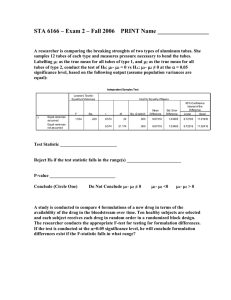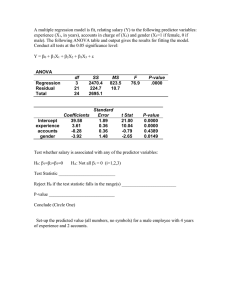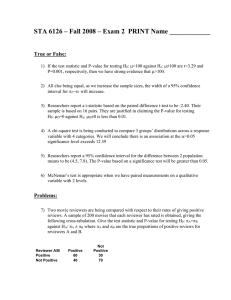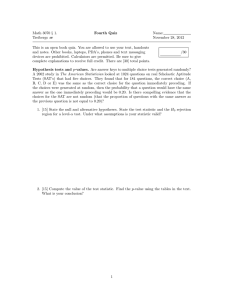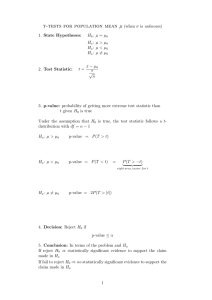Fall 2006 - Exam 2 Solutions
advertisement
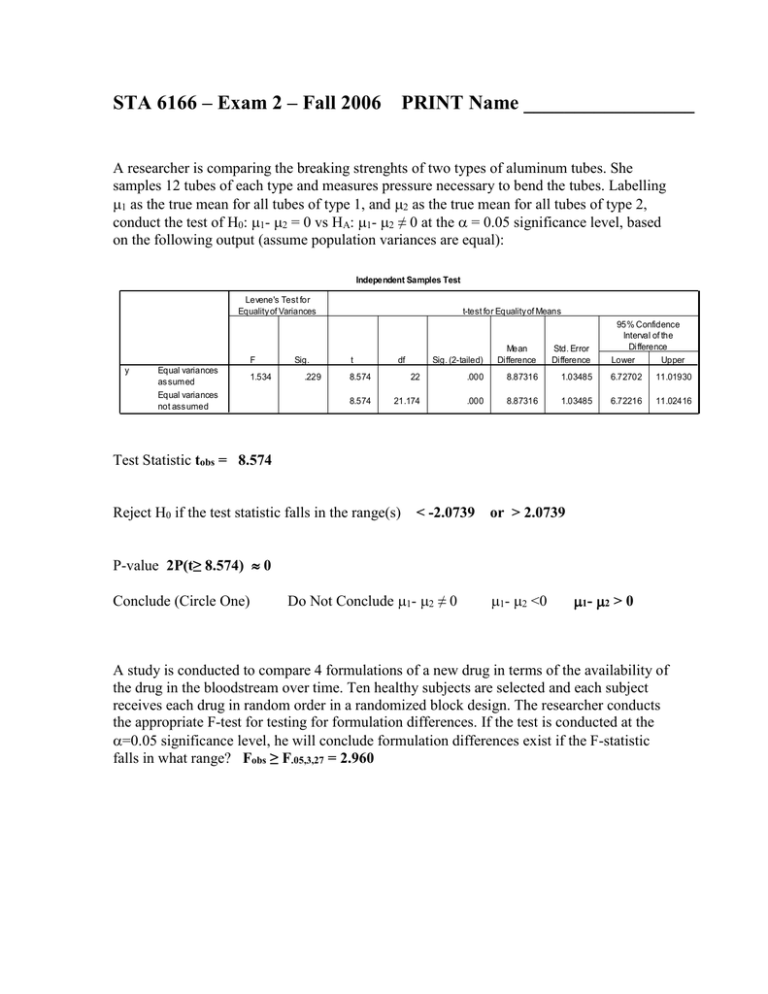
STA 6166 – Exam 2 – Fall 2006 PRINT Name _________________ A researcher is comparing the breaking strenghts of two types of aluminum tubes. She samples 12 tubes of each type and measures pressure necessary to bend the tubes. Labelling 1 as the true mean for all tubes of type 1, and 2 as the true mean for all tubes of type 2, conduct the test of H0: 1-2 = 0 vs HA: 1-2 ≠ 0 at the = 0.05 significance level, based on the following output (assume population variances are equal): Independent Samples Test Levene's Test for Equality of Variances F y Equal variances as sumed Equal variances not ass umed 1.534 Sig. .229 t-test for Equality of Means t df Sig. (2-tailed) Mean Difference Std. Error Difference 95% Confidence Interval of the Difference Lower Upper 8.574 22 .000 8.87316 1.03485 6.72702 11.01930 8.574 21.174 .000 8.87316 1.03485 6.72216 11.02416 Test Statistic tobs = 8.574 Reject H0 if the test statistic falls in the range(s) < -2.0739 or > 2.0739 P-value 2P(t≥ 8.574) 0 Conclude (Circle One) Do Not Conclude 1-2 ≠ 0 1-2 <0 1-2 > 0 A study is conducted to compare 4 formulations of a new drug in terms of the availability of the drug in the bloodstream over time. Ten healthy subjects are selected and each subject receives each drug in random order in a randomized block design. The researcher conducts the appropriate F-test for testing for formulation differences. If the test is conducted at the =0.05 significance level, he will conclude formulation differences exist if the F-statistic falls in what range? Fobs ≥ F.05,3,27 = 2.960 A study is conducted to compare golf ball distances among 4 brands of golf balls. A mechanical driver is set up and hits 12 balls of each brand, and the distance travelled (meters) is measured. The F-test determines that there are differences among the brands. A follow-up comparison based on Tukey’s method yields the following table: Multiple Comparisons Dependent Variable: y Tukey HSD (I) group 1 2 3 4 (J) group 2 3 4 1 3 4 1 2 4 1 2 3 Mean Difference (I-J) St d. E rror -21.40796* 2.51529 -.00121 2.51529 -12.43549* 2.51529 21.40796* 2.51529 21.40675* 2.51529 8.97247* 2.51529 .00121 2.51529 -21.40675* 2.51529 -12.43428* 2.51529 12.43549* 2.51529 -8. 97247* 2.51529 12.43428* 2.51529 Sig. .000 1.000 .000 .000 .000 .005 1.000 .000 .000 .000 .005 .000 95% Confidenc e Int erval Lower Bound Upper Bound -28.1238 -14.6921 -6. 7171 6.7146 -19.1513 -5. 7196 14.6921 28.1238 14.6909 28.1226 2.2566 15.6883 -6. 7146 6.7171 -28.1226 -14.6909 -19.1501 -5. 7184 5.7196 19.1513 -15.6883 -2. 2566 5.7184 19.1501 *. The mean difference is significant at the .05 level. Clearly state what can be said of all pairs of brands at the 0.05 experimentwise error rate. Brands: 1 vs 2: 1 vs 3: 1 vs 4: 2 vs 3: 2 vs 4: 3 vs 4: N.S.D. A study is conducted to compare whether incidence of muscle aches differs among athletes exposed to 5 types of pain medication. A total of 500 people who are members of a large fitness center are randomly assigned to one of the medications. After a lengthy workout, each is given a survey to determine presence/absence of muscle pain. For the 5 groups: 25, 38, 32, 40, and 35 are classified as having muscle pain, respectively. The following output gives the results for the Pearson chi-square statistic for testing (=0.05): H0: True incidence rate of muscle pain doesn’t differ among medications HA: Incidence rates are not all equal Chi-Square Tests Pearson Chi-Square Value 6.150a df 4 Asymp. Sig. (2-sided) .188 Test Statistic 2obs = 6.150 Reject H0 if the test statistic falls in the range(s) ≥ 9.488 P-value .188 Conclude (Circle One): Medication effects not all equal No differences in effects Give the expected number of incidences of muscle pain for each medication under H0: Overall incidence rate: (25+38+32+40+35)/500 = 0.34 Expected incidences per med = .34(100) = 34 In a 2-Factor ANOVA, measuring the effects of 2 factors (A and B) on a response (y), there are 3 levels each for factors A and B, and 4 replications per treatment combination. Give the values of of the F-statistic for the AB interaction for which we will conclude the effects of Factor A levels depend on Factor B levels and vice versa (=0.05): FAB ≥ F.05,4,27 = 2.728 A simple linear regression model is fit, relating plant growth over 1 year (y) to amount of fertilizer provided (x). Twenty five plants are selected, 5 each assigned to each of the fertilizer levels (12, 15, 18, 21, 24). The results of the model fit are given below: Coefficientsa Unstandardized Coefficients Model 1 (Constant) B 8.624 Std. Error 1.810 t 4.764 Sig. .000 .527 .098 5.386 .000 x a. Dependent Variable: y Can we conclude that there is an association between fertilizer and plant growth at the 0.05 significance level? Why (be very specific). Yes, P-value for test of H0: 1 = 0 versus HA: 1 ≠ 0 is .000 (tobs = 5.386) Give the estimated mean growth among plants receiving 20 units of fertilizer. ^ Y 8.624 0.527(20) 19.164 The estimated standard error of the estimated mean at 20 units is 2.1 Give a 95% CI for the mean at 20 units of fertilizer. t.025,23 = 2.0687 CI: 19.164 ± 2.0687(0.46) ≡ (18.212 , 20.116) 1 (20 18) 2 0.46 25 450 A multiple regression model is fit, relating salary (Y) to the following predictor variables: experience (X1, in years), accounts in charge of (X2) and gender (X3=1 if female, 0 if male). The following ANOVA table and output gives the results for fitting the model. Conduct all tests at the 0.05 significance level: Y = 0 + 1X1 + 2X2 + 3X3 + ANOVA df 3 21 24 Regression Residual Total Intercept experience accounts gender Coefficients 39.58 3.61 -0.28 -3.92 SS 2470.4 224.7 2695.1 Standard Error 1.89 0.36 0.36 1.48 MS 823.5 10.7 t Stat 21.00 10.04 -0.79 -2.65 F 76.9 P-value .0000 P-value 0.0000 0.0000 0.4389 0.0149 Test whether salary is associated with any of the predictor variables: H0: HA: Not all i = 0 (i=1,2,3) Test Statistic Fobs = 76.9 Reject H0 if the test statistic falls in the range(s) ≥ 3.072 P-value .0000 Conclude (Circle One) Reject H0 Set-up the predicted value (all numbers, no symbols) for a male employee with 4 years of experience and 2 accounts. ^ Y 39.58 3.61(4) 0.28(2) 3.92(0) 53.46 The following tables give the results for the full model, as well as a reduced model, containing only expereience. Test H0: 2 = 3 = 0 vs HA: 2 and/or 3 ≠ 0 Complete Model: Y = 0 + 1X1 + 2X2 + 3X3 + ANOVA df 3 21 24 Regression Residual Total SS 2470.4 224.7 2695.1 MS 823.5 10.7 F 76.9 Reduced Model: Y = 0 + 1X1 + Regression Residual Total df 1 23 24 SS 2394.9 300.2 2695.1 MS 2394.9 13.1 F 183.5 P-value 0.0000 Test Statistic: Fobs (2470.4 2394.9) / 2 3.53 224.7 / 21 Rejection Region: Fobs ≥ 3.467 Conclude (Circle one): Reject H0 Fail to Reject H0 P-value .0000
